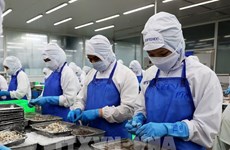Companies urged to focus on food quality
Vietnamese firms need to enhance their role in the food industry value
chain to supply more quality products and increase export of farm
produce, according to the Ministry of Industry and Trade.
Vietnamese firms need to enhance their role in the food industry value
chain to supply more quality products and increase export of farm
produce, according to the Ministry of Industry and Trade.
Speaking at a conference in Ho Chi Minh City on May 14, Deputy Minister of Industry and Trade Do Thang Hai said the agricultural sector not only met local needs with its diverse, quality products but also exported to many countries around the world.
Agricultural exports had increased strongly in recent years to more than 30 billion USD last year, with Vietnam being among the world's largest exporters of many items like cashew, pepper, rice and coffee, he said.
"However, limited processing capacity, and a lack of brands and exports via many intermediaries have resulted in low export earnings."
Held by the Vietnam Trade Promotion Agency on the sidelines of the first Vietnam International Food Industry Exhibition, the conference sought to come up with measures to add value to Vietnamese food products, improve their competitiveness, and promote them globally.
Pham Minh Duc, senior economist at the World Bank in Vietnam, said fragmented land ownership, quality control issues, low quality of seeds and other inputs, and poor techniques and misuse of inputs like water and pesticides were among the challenges faced by the agricultural sector.
"Increasingly liberalised and connected markets will drive competition from other low-cost countries such as Myanmar in rice and Kenya in coffee.
"Long-term sustainability issues related to climate change, especially in low-lying coastal areas, is another challenge."
Vo Thanh Do, Deputy Director of the Department of Processing and Trade for Agro-Forestry-Fisheries Products and Salt Production, said despite efforts to reduce them, post-harvest losses remained high at 20 percent for fruits and vegetables and 11-13 percent for rice, resulting in high production costs and low quality and prices.
Vo Ngan Giang of the UN's Food and Agriculture Organisation said demand for many kinds of food, including meat, milk, eggs, rice, wheat, and cereal had shot up in the global market.
With the global population rising, an additional one billion tonnes each of cereals and beef and 460 million tonnes of meat are expected to be needed each year by 2050. With more people entering the middle class, demand for meat and high added-value food products are expected to rise.
Duc said Vietnamese firms had an opportunity to expand their markets through greater regional and global integration through the ASEAN Economic Community, the Vietnam-EU free trade agreement, and the Trans Pacific Partnership.
It would be hard for Vietnam to increase exports of many kinds of agricultural products since they had reached peak output levels, and the firms should instead focus on increasing their value-addition, he said.
They needed to improve quality management through the entire value chain from production to consumption to meet consumers' food safety demand, he said.
Do said the agricultural sector was taking steps to restructure production with a focus on quality, value, efficiency, competitive capacity and protecting the environment. By 2020 the agro-forestry and fisheries sector's value addition was expected to increase by 20 percent, and post-harvest losses would reduce by 20 percent.-VNA
Speaking at a conference in Ho Chi Minh City on May 14, Deputy Minister of Industry and Trade Do Thang Hai said the agricultural sector not only met local needs with its diverse, quality products but also exported to many countries around the world.
Agricultural exports had increased strongly in recent years to more than 30 billion USD last year, with Vietnam being among the world's largest exporters of many items like cashew, pepper, rice and coffee, he said.
"However, limited processing capacity, and a lack of brands and exports via many intermediaries have resulted in low export earnings."
Held by the Vietnam Trade Promotion Agency on the sidelines of the first Vietnam International Food Industry Exhibition, the conference sought to come up with measures to add value to Vietnamese food products, improve their competitiveness, and promote them globally.
Pham Minh Duc, senior economist at the World Bank in Vietnam, said fragmented land ownership, quality control issues, low quality of seeds and other inputs, and poor techniques and misuse of inputs like water and pesticides were among the challenges faced by the agricultural sector.
"Increasingly liberalised and connected markets will drive competition from other low-cost countries such as Myanmar in rice and Kenya in coffee.
"Long-term sustainability issues related to climate change, especially in low-lying coastal areas, is another challenge."
Vo Thanh Do, Deputy Director of the Department of Processing and Trade for Agro-Forestry-Fisheries Products and Salt Production, said despite efforts to reduce them, post-harvest losses remained high at 20 percent for fruits and vegetables and 11-13 percent for rice, resulting in high production costs and low quality and prices.
Vo Ngan Giang of the UN's Food and Agriculture Organisation said demand for many kinds of food, including meat, milk, eggs, rice, wheat, and cereal had shot up in the global market.
With the global population rising, an additional one billion tonnes each of cereals and beef and 460 million tonnes of meat are expected to be needed each year by 2050. With more people entering the middle class, demand for meat and high added-value food products are expected to rise.
Duc said Vietnamese firms had an opportunity to expand their markets through greater regional and global integration through the ASEAN Economic Community, the Vietnam-EU free trade agreement, and the Trans Pacific Partnership.
It would be hard for Vietnam to increase exports of many kinds of agricultural products since they had reached peak output levels, and the firms should instead focus on increasing their value-addition, he said.
They needed to improve quality management through the entire value chain from production to consumption to meet consumers' food safety demand, he said.
Do said the agricultural sector was taking steps to restructure production with a focus on quality, value, efficiency, competitive capacity and protecting the environment. By 2020 the agro-forestry and fisheries sector's value addition was expected to increase by 20 percent, and post-harvest losses would reduce by 20 percent.-VNA












